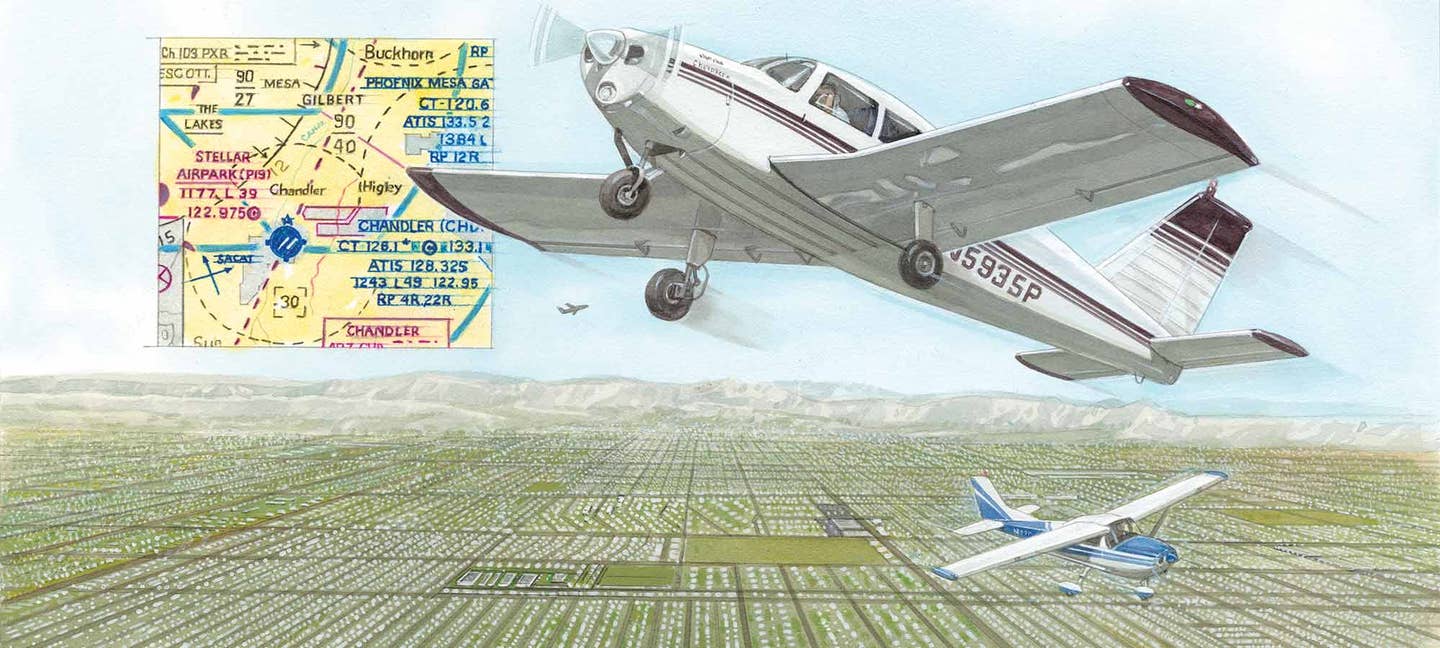
They say a pilot never stops learning. But that’s not true. Complacency can set in right around the time we’ve forgotten what flaming tomatoes have to do with flying airplanes. We realize that most flights go just fine, and without a healthy spook now and then, we reach a learning plateau. My first spook hit me on a bright spring day over suburban Phoenix.
There are two certainties about bright spring days in that airspace. It’s warm, and it’s crowded. Combine several large flight schools training foreign airline cadets with a Class B international airport and you’ll learn the limitations of see-and-avoid.
Departing Falcon Field (KFFZ) en route to Yuma, Arizona (KNYL), I opted to squirm out from under the Phoenix Class B airspace by heading south-southwest over Chandler (KCHD). That route enables VFR pilots to escape the area by sliding between a lower shelf of the Class B and the Phoenix-Mesa Gateway (KIWA) airspace. It can get busy. Especially over Chandler, where avoiding towered airspace means exiting and entering the corridor between 3,000 and 4,000 feet msl. At its narrowest, the corridor is a thousand feet tall and a couple of miles wide.
Not long after I checked in with Phoenix Approach, the controller called out traffic at my 2 o’clock, same altitude. Focusing my scan in that direction, I saw nothing and reported “looking.” The pilot of the other airplane was not on the frequency. Moments passed. Another call-out from the controller. Still looking, more urgently. Still nothing spotted.
As I considered how to alter course for the invisible airplane, using proper right-of-way procedures, I had a worry that we were converging. Then came the command from approach, firmly: “Climb immediately.” Having read too many reports of midair collisions over our local airspace, my focus narrowed. Now, it was primal. Throttle in, yoke back. Oddly enough, as the horizon fell, the choice between Vx and Vy crossed my mind. A ridiculous thought, given the circumstances. I laughed to myself, if only for a millisecond. Back in reality, I kept pulling until what seemed like a 45-degree climb but must’ve been less. Reality again: I was about to pierce the floor of the Phoenix Class B airspace. I wasn’t far beneath it to begin with. “I’m gonna bust the Bravo. Is that OK?” I was cleared into the Class B before my mouth was shut.
Nose down quickly to maintain Vx, and then it was all over. The controller let me know I was clear of the traffic, and I descended out of the Class B and went on my way. The drone of the engine gave way to reflection within my stupefied mind as I assessed how close I had come to real danger. It was stunning to think that only a few seconds earlier I’d been forced to blindly expose the belly of my airplane to an unknown threat. I never saw the other airplane, and even if the worst had happened I probably never would have seen it. Shock gave way to anger. Why would another pilot blow through a busy VFR corridor without taking advantage of the services our great local approach controllers offer? I did everything right. Someone else screwed up and scared me. How dare they!
Lessons learned? I suppose. Maybe I’m not all that perfect. Maybe I could’ve flown through the positive-control Class D airspace below, where any threatening traffic would at least be on the tower frequency with me. There could’ve been a good reason why the other pilot wasn’t using flight following.
Honestly, though? What I did was not only perfectly legal, but reasonable under the circumstances. I chose the route that would allow the highest legal altitude for my route of flight, just under the Class B. Flying lower would’ve posed its own, different risks, and I would’ve cursed myself had I run into engine trouble in a single-engine airplane at needlessly low altitude over an unforgiving expanse of subdivisions and strip malls.
Most pilots have had at least one close brush with traffic, and the real lesson I learned is less about traffic avoidance than about the nature of flying itself. I learned that same lesson at 10,500 feet over the vast, indistinguishable expanse of western Texas when my tablet’s GPS feed cut out. I used the sparingly equipped Cherokee’s sole VOR receiver to triangulate a position relative to the Big Spring and Midland VORs, and a sheepish request for a vector to Andrews confirmed that I was still on course. No big deal in the end, but the sensation of feeling “lost,” if only for a moment, made an impression.
The lesson learned over Chandler and again over Texas, I think, is that even if a pilot does absolutely nothing wrong, some threat, even if minor, is lurking out there. No pilot will completely eliminate the risk inherent in riding man-made aluminum (or composite) contraptions through the air. That beast simply cannot be tamed.
Phrased differently, the lesson is simply to appreciate flying for what it is. It is the marriage of beauty and vulnerability, and the vulnerability has its own allure. Not because of some reckless daredevil mentality, but because the goal of a flight well and safely flown, everything “done right,” can so preoccupy the mind that it shuts out everything else. The stressors of everyday life seem — and actually become, if only for the moment — frivolous.
The plateau is crossed, and it’s back up the learning curve again. It’s the same curve traversed by childhood idols such as Richard Collins, Peter Garrison and every other pilot who typifies “professional” aviation even if their paycheck doesn’t come from an airline or corporate flight department.
I’m excited to follow them up that curve. Bring it on.

Subscribe to Our Newsletter
Get the latest FLYING stories delivered directly to your inbox






